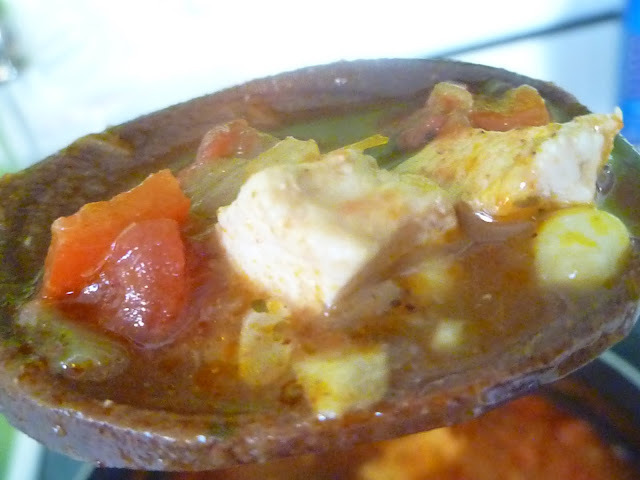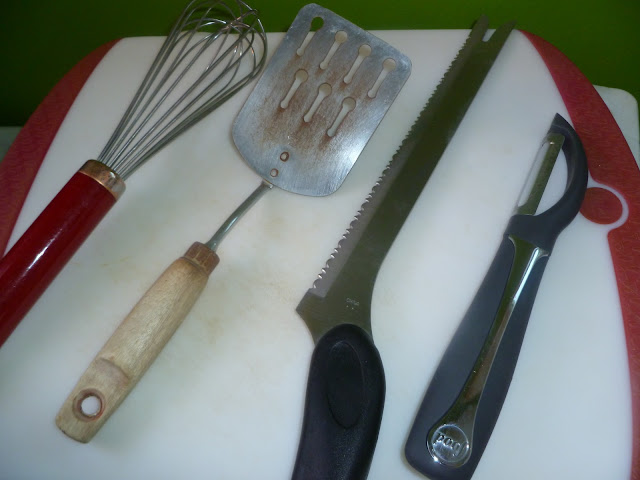When I think of pancakes, I think of Sunday mornings. I think of everyone in the kitchen together. I think of wholesomeness and family. But mostly I think I'm hungry.
The Kid loves pancakes. She would eat pancakes every day if that was nutritionally okay. I know one person who tries to go out to breakfast every weekend for pancakes. But why go out when you can make them at home? You don't even have to get dressed. Heck, you can make pancakes in the nude if you want. Just don't tell me about it later.
Pancakes are easy to make and homemade pancakes taste so much better than the ones from a box. Everything here (except maybe the buttermilk) is an ingredient that should be part of your basic pantry staples.
 This recipe starts with a very white, very boring-looking bowl of dry ingredients. There's flour, sugar, baking soda, baking powder, and salt here.
This recipe starts with a very white, very boring-looking bowl of dry ingredients. There's flour, sugar, baking soda, baking powder, and salt here. I whisk all the dry ingredients together. So much easier than sifting.
Next I get the wet ingredients ready.
This measuring cup holds melted butter, milk, and buttermilk.
Try, if you can, to have the eggs, milk, and buttermilk be room temperature. That way, the melted butter won't re-solidify when you combine them.
If you can't, that's okay. Your pancakes will still turn out okay.
Pour the wet ingredients into the dry. You'll want to wait to do this until just before you plan on making the pancakes. The longer the batter sits, the less effective the baking powder and baking soda will be, and so your pancakes will be less fluffy.
Crack in two eggs as well.
I just love how the eggs look, framed by the buttermilk. It makes me want to go for a swim.
Whisk everything together until just combined. Don't stir too long or you'll get tough pancakes. Just enough to make sure the dry ingredients are thoroughly wetted.
While you were mixing up your pancakes, your griddle should have been preheating. I have a nifty electric griddle someone gave us for our wedding. It has come in so handy.
The temperature you use will totally depend on your griddle. Ours is perfect at 375F.
Or you could just do the "Grandma Test" and drip some water onto the griddle. If it sizzles, your griddle is ready!
If you're wondering why the griddle looks kind of dirty, I cooked the bacon and sausage on the griddle before I did the pancakes. Those first few pancakes are so delicious and bad for you I can't even explain it.
Watch your cakes. When they start to puff up and bubble in the middle, they're ready to flip.
If you like flavored pancakes, now would be the time to sprinkle on chocolate chips, blueberries, strawberries, or bananas.
If you like flavored pancakes, now would be the time to sprinkle on chocolate chips, blueberries, strawberries, or bananas.
Flip!
When the middle of the pancake starts to puff up, that means your pancake is done.
When the middle of the pancake starts to puff up, that means your pancake is done.
Some people make an enormous "blanket" pancake to keep the other pancakes warm underneath. I find an enormous pancake too hard to flip. Our griddle has wells to drain off grease, too, and the batter tends to run that way when you pour too much. We'd probably end up with a bizarrely oval blanket cake. So instead I just put a plate in my oven and set it to around 200F. Pancakes fresh off the griddle go into the oven to stay warm.
When they're done, be sure to serve your cakes with syrup. Real syrup. None of that fake stuff made with high fructose corn syrup. People work hard to make maple syrup. Might as well help them out and appreciate the good stuff!
Recipe: Buttermilk Pancakes
1 1/2 c. flour
2 tbsp. granulated sugar
1 1/2 tsp. baking powder
3/4 tsp. baking soda
1 tsp. salt
3 tbsp. butter, melted
1/4 c. milk, room temperature
1 1/2 c. buttermilk, room temperature
2 eggs, room temperature
Combine dry ingredients; whisk together.
Combine wet ingredients.
Pour wet ingredients into dry ingredients. Crack in eggs. Whisk everything together until just combined.
Cook pancakes on a griddle or in a frying pan. If you're unfamiliar with your griddle, you might need to use a couple pancakes to test, to make sure they get cooked all the way through. My griddle does best at 375F.
When pancakes begin to bubble in the center, flip them over and cook until middles have risen up and griddle-side-down side is golden brown.
Serve with maple syrup, butter, Karo syrup (if you're a grandma--hey, that's what my grandma pours on hers), molasses, cinnamon and sugar, or jam.
















































